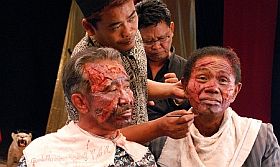Jeg fortsætter mine gensyn med Per Kirkebys film, som så lykkeligt er dukket op på Filmstriben. Nu altså Ekspeditionen (1988), som vist nok aldrig har været i distribution, men som jeg sært kender alligevel. Noget af materialet er optaget, da Kirkeby og Teit Jørgensen lavede Geologi – er det egentlig videnskab? (1980)
”Det er om Eigil og mig og Pearyland”, siger stemmen, om det handler den varde, som blev rejst af dem i landskabet der. Forstår jeg, da jeg ser den senere. Det var sommeren 1963 han var med på Eigils ekspedition, og det fortæller fortællestemmen sådan lige ud ad vejen, og stemmen er Per Kirkeby, det kan jeg jo høre, og Eigil er Eigil Knuth, det ved jeg. Billederne er fotografier, stills, som det siges i filmsproget, og de er sært slørede og gamle, det er arkivstof, ja, men helt umanipuleret, upoleret og ikke på nogen måde strammet op. Så fortæller fortællestemmen, altså Kirkeby, at han nu, han er i gang med den her film, må han erklære, at han har mistet lysten til det filmiske, at han vil fortælle om denne personligt skelsættende begivenhed, ekspeditionen i sit liv, som i hans sind vokser som drøm og forestilling og gennemtænkning til hele mytologien om ekspeditionerne i dette grønlandske landskab, hvor døden får sin ikke fortrængte plads, så livet bliver til fylde, det vil han fortælle om i en lysbilledserie. Og jeg forstår, at Teit Jørgensen er sat til at filme lysbillederne, mens Kirkeby viser dem med sit lysbilledapparat på lærredet og ind imellem med sin finger peger på en bestemt linje i det viste landskab, noget, han vil pointeret, som han derefter i sit store værk, akvarellerne og malerierne atter og atter har pointeret.
Og så med ét forsvinder stemmen, og der bliver stille, ikke klodset stille som et lydhul, nej hensynsfuldt stille som ønsket: se nu på de her billeder! Og jeg ser og ser og tror, jeg forstår det ufortællelige og bliver rørt over, at han ved, jeg også har det i mig, indtænker alt det, han ved, jeg ved, alt det, jeg har set og læst. Og netop som det er klart for mig, hvad det er, får jeg belønningen, Hans Andersen (ved jeg senere fra et tekstskilt) spiller tuba, det er filmmusik. Af Henning Christiansen, kan jeg gå ud fra som selvfølge.
Det kan godt være, at det er en forudsætning for, at jeg opfatter den intense skønhed i Kirkebys film (ikke kun den, mange af dem, måske dem alle), at jeg ved lidt om baggrunden for eksempel billedsidens radikalitet. Manden er jo maler og han mener noget med billederne, de er ikke tilfældige eller sjuskede, som jeg først kunne mene, så de kan selvfølgelig ikke uden videre afvises. Men det er for mig nødvendigt at studere deres forudsætninger, som er en helt anden æstetik end den, jeg er vænnet til og til dels skolet i. Det har hjulpet mig meget at læse, hvad han skriver om det. Som nu her om Teit Jørgensens fotografi (i det hele taget), som han beundrer: Tilbage i december 1976 skriver Per Kirkeby om kvaliteten af de mere nøgterne kompositioner, der afspejler en accept af ”procesessens almindelighed”:
”… Forstår fotografen dette, bliver hans billeder hverken platte eller demonstrativt tilbydende (…). Billederne får den klare redegørelse for udstrækninger og rum, figurer og størrelser, den rolige klarhed som bliver erindringens og stedernes magi. (…) Meget få fotografer når denne indsigt i simpelheden, de fleste frygter den faktisk og står på hovedet. (…) Men ud af den fotografiske dokumentation, denne simpelhed, vokser stemninger uden ord. Tænk det lader sig se. Teit Jørgensen er en dansk fotograf der har disse kvaliteter. Hans billeder er ikke demonstrative, men de viser at dette lader sig se. Hans billeder har denne rolige udstråling”
Danmark 1988, 31 min. Manuskript: Per Kirkeby, fotografi: Teit Jørgensen, klip: Grete Møldrup, musik: Henning Christiansen, fortællerstemme: Per Kirkeby, produktion: Vibeke Windeløv / Kraka Film, distribution: Filmstriben. Litt.: Per Kirkeby: Ekspeditionerne i Fisters klumme, 1995. Per Kirkeby citatet er fra teksten Fotografen i Victor B. Andersen’s Maskinfabrik, december 1976, side 86. Her citeret via en hjemmeside (uden årstal) om Teit Jørgensens separatudstilling ”Snapshots & Stills” i Galleri Tom Christoffersen.



